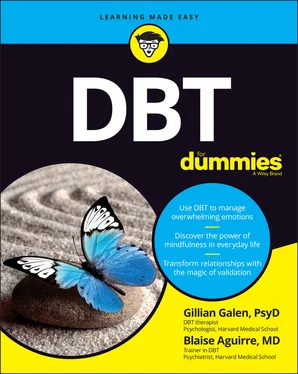The following sections provide pointers on how to effectively use the space between an impulse and an action in order to make different choices.
Taking a breath to target impulsivity isn’t some theoretical exercise; a research base shows that it helps. For instance, in one study, more than 500 teens aged 14 to 18 who went through a four-week program where they learned yoga-based breathing techniques had better impulse control than a comparison group of teens who didn’t go through the program.
Taking a breath is an excellent way to deal with an urge to do something impulsive. A focus on the breath is a way to reach the gap between the urge and the action, and the more you practice this, the more you’ll see that this gap exists. Also, the more you practice this, the bigger you will see that the gap is. Although you’re breathing all the time, it’s unlikely that you’re paying attention to each of your breaths. This is particularly true when an impulsive action is about to happen in the context of high emotions.
 Here is a way to focus on the breath:
Here is a way to focus on the breath:
1 Take a deep, slow breath in through your nose. This inward breath should last somewhere from four to six seconds.
2 Breathe out through pursed lips, as if you were blowing up a balloon. The outward breath should last longer than the inward breath — for instance, five to eight seconds.
3 Focus on breathing this way for about two minutes. After a few minutes, pay attention to the point when the inward breath stops and the outward breath begins.
 In this book, you should practice all the recommended exercises when you don’t need them, so that when you do need them, they are available. It’s the same as taking practice tests before an exam, so that when the exam comes, you’re ready, or practicing tennis before the match, so that when the match comes, you know what to do.
In this book, you should practice all the recommended exercises when you don’t need them, so that when you do need them, they are available. It’s the same as taking practice tests before an exam, so that when the exam comes, you’re ready, or practicing tennis before the match, so that when the match comes, you know what to do.
 The next time you’re likely to do something impulsive, practice this breath for five minutes. You might still decide that you’re going to engage in the behavior based on your urges, but on the other hand, when you slow down, the pause might allow you to fully consider the consequence of your actions.
The next time you’re likely to do something impulsive, practice this breath for five minutes. You might still decide that you’re going to engage in the behavior based on your urges, but on the other hand, when you slow down, the pause might allow you to fully consider the consequence of your actions.
Finding your emotional balance
Experiencing stressful situations and having no time to unwind can lead to psychological distress. The thought of dealing with life’s stress can feel impossible, and many people choose to ignore or avoid dealing with problems that come along. DBT teaches that avoidance of dealing with stress can lead to more stress, and so rather than avoiding the stress, finding emotional balance is a way to manage these situations.
 But what is emotional balance and how do you achieve it? Typically, when in the heat of an unwanted situation, most of us react with strong emotions — typically anger, fear, anxiety, worry, or sadness. Having emotional balance is the practice of balancing these unwanted emotions using effective ways of dealing with them so that you don’t end up stuck in them or spend your time ruminating about how terrible and unfair life is. Finding this balance is also a way to increase happiness, improve motivation to do things differently, and help you get a good night’s rest.
But what is emotional balance and how do you achieve it? Typically, when in the heat of an unwanted situation, most of us react with strong emotions — typically anger, fear, anxiety, worry, or sadness. Having emotional balance is the practice of balancing these unwanted emotions using effective ways of dealing with them so that you don’t end up stuck in them or spend your time ruminating about how terrible and unfair life is. Finding this balance is also a way to increase happiness, improve motivation to do things differently, and help you get a good night’s rest.
Specific steps can help you practice, build, and maintain emotional balance. SUN, WAVE, and NO NOT are ways to do this, as you find out in the following sections. You can also practice gratitude and use behavioral activation.
In finding balance, you can use emotion regulation skills (see Chapter 10) along with distress tolerance skills (see Chapter 11). When you use emotion regulation skills, you focus on dealing with difficult emotions without acting on behaviors that might have adverse consequences. On the other hand, distress tolerance skills are used for the tolerance and momentary acceptance of difficult situations without making the situations worse. Using all of these ideas on a regular basis is the DBT way to find emotional balance.
Identifying the emotion: SUN
 Many people who struggle with emotional intensity and reactivity recognize that they don’t know precisely which emotion they are feeling, and so it makes sense that they might not know what to do when they are feeling unbalanced. One way to identify the emotion is to use the acronym SUN:
Many people who struggle with emotional intensity and reactivity recognize that they don’t know precisely which emotion they are feeling, and so it makes sense that they might not know what to do when they are feeling unbalanced. One way to identify the emotion is to use the acronym SUN:
Sensations: Focus on what you feel and the physical sensations in your body. Notice whether there is tension in any part of your body.
Urges: Do you have any urges to do anything in particular? Most emotions come with an action urge. For instance, people who are angry have the urge to attack, while people who are sad have the urge to cry or isolate.
Name (the emotion): When you put together the body sensations and action urges, it’s easier to name the emotion.
Riding out the emotion like a WAVE
Emotions are like waves: They will start to form, peak, and then come crashing down before petering out on the beach. The idea is to focus on the emotion, to notice it as it peaks, and then to ride it down until it is more manageable before acting on the urges.
Here, the task is to remind yourself that you are not your emotion. So, rather than saying “I am sad,” say “I feel sad.” By doing this, you aren’t making yourself and sadness equivalent. Also, if sad is who you are, then you can’t change that; however, if sadness is how you feel, then that is something that you can change. The task here is also not to enhance or suppress the emotion, because doing so makes a stressful situation even worse.
 Another way to find balance, besides SUN-WAVE-NO NOT, is to practice finding gratitude for things in your life. There are always things in life that we can be thankful for. Many people think that this isn’t true because they don’t have “big” things. And yet there are often little things for which we can have gratitude: a kind smile from another person, a silent moment, the sound of birds in a garden, the end of a busy workday. By following this practice, you remind yourself that life isn’t made up of a series of unfortunate or unwanted effects.
Another way to find balance, besides SUN-WAVE-NO NOT, is to practice finding gratitude for things in your life. There are always things in life that we can be thankful for. Many people think that this isn’t true because they don’t have “big” things. And yet there are often little things for which we can have gratitude: a kind smile from another person, a silent moment, the sound of birds in a garden, the end of a busy workday. By following this practice, you remind yourself that life isn’t made up of a series of unfortunate or unwanted effects.
Behavioral activation, a.k.a “get moving!”
Physical movement is a way to tackle emotional lows. Behavioral activation is based on the observation that, as a person becomes depressed, they increasingly engage in isolating and avoidance behaviors. The goal of behavioral activation, therefore, is to work with people who have unwanted mood states like depression by engaging in activities that have been shown to improve mood. Often, these are activities that a person enjoyed before they became depressed. These activities don’t need to be excessive. If a person enjoyed running before their depression, they don’t have to run a half-marathon to get moving. They might jog around the block or go for a 30-minute walk. The task is to make movement a part of their daily routine.
Читать дальше

 Here is a way to focus on the breath:
Here is a way to focus on the breath: The next time you’re likely to do something impulsive, practice this breath for five minutes. You might still decide that you’re going to engage in the behavior based on your urges, but on the other hand, when you slow down, the pause might allow you to fully consider the consequence of your actions.
The next time you’re likely to do something impulsive, practice this breath for five minutes. You might still decide that you’re going to engage in the behavior based on your urges, but on the other hand, when you slow down, the pause might allow you to fully consider the consequence of your actions.










